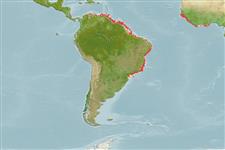Common names from other countries
Classification / Names / Names
Namen | Synonyme | Catalog of Fishes (gen., sp.) | ITIS | CoL | WoRMS
Environment: milieu / climate zone / depth range / distribution range
Ökologie
; tiefenbereich 0 - 30 m (Ref. 83435). Tropical; 12°N - 28°S, 62°E - 0°E (Ref. 83435)
Atlantic Ocean: Trinidad and Tobago to Brazil, and tropical West Africa.
Length at first maturity / Size / Gewicht / Alter
Maturity: Lm ? range ? - ? cm Max length : 16.6 cm DL Männchen/unbestimmt; (Ref. 83435); common length : 16.0 cm TL Männchen/unbestimmt; (Ref. 355)
Shell fusiform, spire high, anterior canal well developed, shell surface with sculpture of many fine spiral threads. Shoulder angular, with single row or nodules. Periostracum thick and hairy. Colour: chocolate brown to black, with a few contrasting white bands, periostracum brownish.
Lives on mud and other soft substrates in mangrove areas and near river estuaries. Feeds mainly on carrion (Ref. 355).
Life cycle and mating behavior
Geschlechtsreife | Fortpflanzung | Ablaichen | Eier | Fecundity | Larven
This species is a non-broadcast spawner. Life cycle does not include trocophore stage. Also Ref. 833.
Leal, J.H. 2003. (Ref. 355)
IUCN Rote Liste Status (Ref. 130435)
CITES Status (Ref. 108899)
Not Evaluated
Not Evaluated
Bedrohung für Menschen
Harmless
Nutzung durch Menschen
| FishSource |
Tools
Mehr Information
Alter/GrößeWachstumLänge-GewichtLänge-LängeMorphologieLarvenDichte
Internet Quellen
Estimates based on models
Preferred temperature
(Ref.
115969): 26.7 - 28.3, mean 27.5 (based on 255 cells).
Preiskategorie
Unknown.
